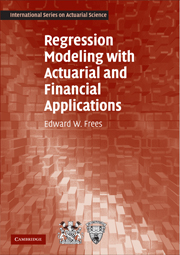Book contents
- Frontmatter
- Contents
- Preface
- 1 Regression and the Normal Distribution
- Part I Linear Regression
- 2 Basic Linear Regression
- 3 Multiple Linear Regression – I
- 4 Multiple Linear Regression – II
- 5 Variable Selection
- 6 Interpreting Regression Results
- Part II Topics in Time Series
- Part III Topics in Nonlinear Regression
- Part IV Actuarial Applications
- Brief Answers to Selected Exercises
- Appendix 1 Basic Statistical Inference
- Appendix 2 Matrix Algebra
- Appendix 3 Probability Tables
- Index
3 - Multiple Linear Regression – I
Published online by Cambridge University Press: 05 June 2012
- Frontmatter
- Contents
- Preface
- 1 Regression and the Normal Distribution
- Part I Linear Regression
- 2 Basic Linear Regression
- 3 Multiple Linear Regression – I
- 4 Multiple Linear Regression – II
- 5 Variable Selection
- 6 Interpreting Regression Results
- Part II Topics in Time Series
- Part III Topics in Nonlinear Regression
- Part IV Actuarial Applications
- Brief Answers to Selected Exercises
- Appendix 1 Basic Statistical Inference
- Appendix 2 Matrix Algebra
- Appendix 3 Probability Tables
- Index
Summary
Chapter Preview. This chapter introduces linear regression in the case of several explanatory variables, known as multiple linear regression. Many basic linear regression concepts extend directly, including goodness-of-fit measures such as R2 and inference using t-statistics. Multiple linear regression models provide a framework for summarizing highly complex, multivariate data. Because this framework requires only linearity in the parameters, we are able to fit models that are nonlinear functions of the explanatory variables, thus providing a wide scope of potential applications.
Method of Least Squares
Chapter 2 dealt with the problem of a response depending on a single explanatory variable. We now extend the focus of that chapter and study how a response may depend on several explanatory variables.
Example: Term Life Insurance. Like all firms, life insurance companies continually seek new ways to deliver products to the market. Those involved in product development want to know who buys insurance and how much they buy. In economics, this is known as the demand side of a market for products. Analysts can readily get information on characteristics of current customers through company databases. Potential customers, those who do not have insurance with the company, are often the main focus for expanding market share.
In this example, we examine the Survey of Consumer Finances (SCF), a nationally representative sample that contains extensive information on assets, liabilities, income, and demographic characteristics of those sampled (potential U.S. customers).
- Type
- Chapter
- Information
- Publisher: Cambridge University PressPrint publication year: 2009

